Are you looking for the best size tattoo needle to get the thickest lines? Whether you’re a professional tattoo artist or just starting out, you want to make sure you have the right size needle for the job. In this article, we’ll discuss what size tattoo needle gives you the thickest lines and how to choose the right one for your project. We’ll also cover the benefits and drawbacks of each size needle and explain the differences between them. By the end of this article, you’ll have a better understanding of what size tattoo needle to choose for your next tattoo.
Contents
How to Read Tattoo Needle Sizes
Tattoo needles come in a variety of sizes, each of which will create a different look when tattooing. Here’s a breakdown of what each size means:
- Round Liners (RL): These are the most common type of needles and come in sizes ranging from 0.25 to 12. A smaller number means a finer line, while a larger number creates a thicker line.
- Flat Shaders (FS): These needles come in sizes ranging from 4 to 15, with a larger number creating a thicker line.
- Magnums (M1, M2, M3): These needles are designed to create a more solid line and come in sizes ranging from 3 to 14, with a larger number creating a thicker line.
- Curved Magnum (CM): These needles are used for creating curved lines and come in sizes ranging from 3 to 14, with a larger number creating a thicker line.
To get the thickest lines possible, it’s important to use the right size needle for your desired outcome. Generally, magnums and curved magnums will give you the thickest lines, but it’s important to remember that a larger size needle may not always be the best option. Depending on the style of tattoo you’re trying to achieve, a smaller size needle may be more effective.
What Does RS Mean on Tattoo Needles?
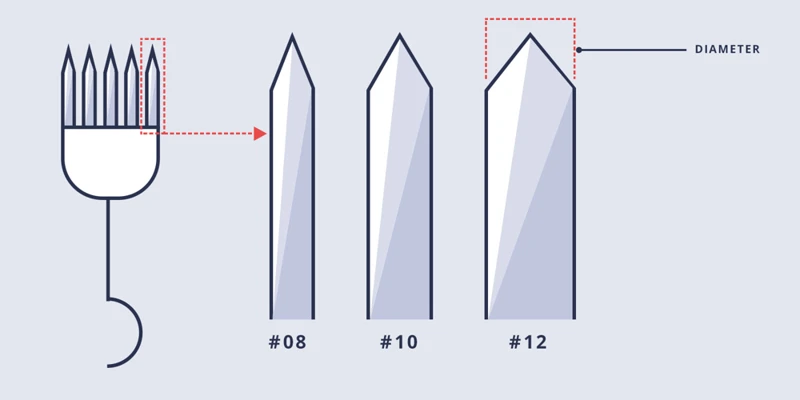
Tattoo needles are labeled with different abbreviations and numbers, and one of them is RS. This stands for “Round Shader” and refers to a type of needle used for shading.
The size and configuration of a Round Shader needle will vary depending on the manufacturer. Generally, these needles are made up of a round grouping of needles that are arranged in a circular pattern. This allows for a greater amount of ink to be released in a single pass, which results in thicker lines.
Here are some of the common sizes and configurations of Round Shader needles:
- RS-3: A three-pronged needle that is used for outlining and shading
- RS-4: A four-pronged needle that is used for outlining and shading
- RS-6: A six-pronged needle that is used for outlining and shading
- RS-8: An eight-pronged needle that is used for shading and creating gradients
- RS-12: A twelve-pronged needle that is used for shading and creating gradients
- RS-14: A fourteen-pronged needle that is used for shading and creating gradients
These needles are often used in combination with other needles, such as Round Liner needles, to create a variety of different effects. When used correctly, Round Shader needles can help to create a smooth and even shading effect.
If you’re looking to create thick, bold lines then a Round Shader needle is a great option. They are also an excellent choice for creating gradients and blending colors.
When selecting a needle size, it is important to take into account the size of the area you’re working on. For large areas, a larger needle size is recommended, while for smaller areas, a smaller needle size is recommended.
Ultimately, the size of the needle that will give you the thickest lines will depend on the type of work you’re doing, the size of the area, and the type of needles you’re using.
By understanding the different types of needles available, and the effects they can create, you can choose the one that best suits your needs.
Keyword: what does rs mean on tattoo needles
What Size Tattoo Needle Gives You the Thickest Lines?
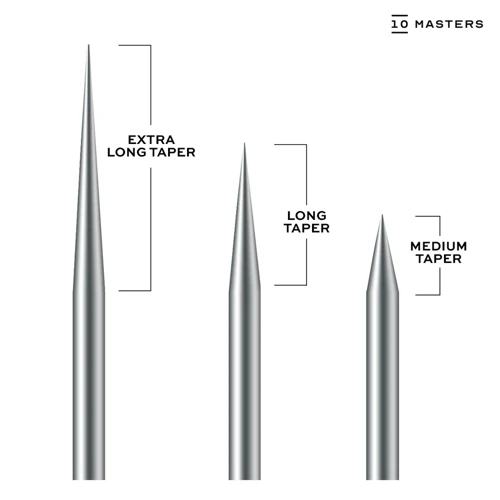
The size of the tattoo needle used has a great influence on the outcome of the tattoo. When it comes to getting the thickest lines, the larger the needle, the better. A larger gauge tattoo needle will create thicker, bolder lines with more ink. The most commonly used needle size for creating bolder lines is an 8-round needle. This size needle has eight small holes in it, allowing for more ink to flow through and create thicker lines.
For shading, a smaller gauge needle is often used. A 7-round needle is the most commonly used for shading, as it is slightly smaller than an 8-round and will create finer lines. Using a larger needle for shading could cause the lines to be too thick and overpower the design.
Overall, the thicker the lines desired, the larger the gauge needle should be. An 8-round needle is the best option for creating bolder lines, while a 7-round is the best choice for shading.
What Tattoo Needle is Best for Shading?
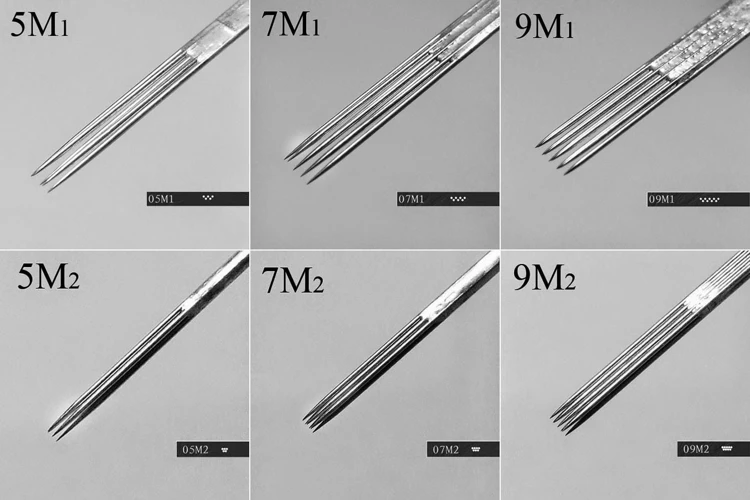
Shading requires needles with a larger, more open grouping of needles than those used for line work. The most popular needle type for shading is the Magnum needle. The Magnum needle is a thicker, more robust needle that offers a larger area of contact with the skin, allowing for more ink to be deposited in a single pass. This increases the saturation of color, giving a deeper and more realistic shading effect.
| Needle Type | Description |
|---|---|
| Magnum | Thicker, more robust needle with a larger area of contact for deeper, more realistic shading. |
The Magnum needle is commonly used for shading, as well as for creating larger, bolder lines. It is also used for what are magnum tattoo needles used for, such as large tribal designs, Japanese style tattoos and other larger pieces. The Magnum needle is available in a variety of groupings, from single-needle to double-stack, so it can be tailored to the desired outcome.
What are Magnum Tattoo Needles Used For?

- Magnum tattoo needles are used for creating thicker, bolder lines with a tattoo machine. They are also used for shading and creating three-dimensional effects.
- The size of the needle is larger than the standard round liner or shader, which allows for more ink to be pushed through the tip of the needle.
- Magnum needles are generally used for larger tattoos, as their size and shape make them more suitable for covering larger areas.
- They are also ideal for shading, as they provide more coverage and better saturation of colour.
- A wide range of needle configurations are available, from a single needle up to four needles in a round magnum configuration.
- The number of needles in a magnum configuration will depend on the type of line work or shading desired.
- The larger size of the magnum needle allows for a smoother, more even application of ink.
- The larger size also means that the needle can penetrate deeper into the skin, which can reduce the amount of time needed to complete a tattoo.
What are M1 Tattoo Needles Used For?
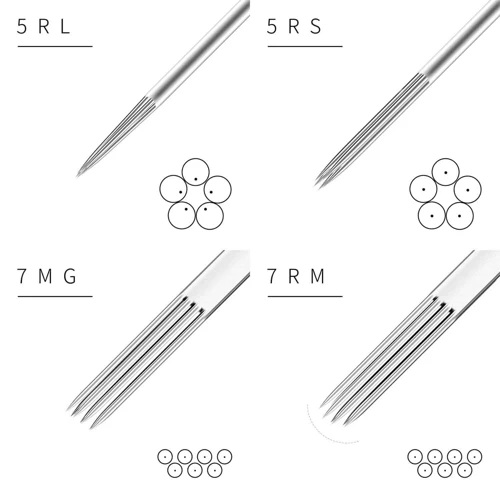
- M1 tattoo needles are used for lining, shading and creating bold lines.
- They are composed of two rows of needles that are arranged in a circular pattern.
- One row is slightly larger than the other, allowing the artist to create a variety of line widths.
- M1 tattoo needles are ideal for creating thick, bold lines and for shading larger areas.
- These needles are generally used for dark, bold artwork and are suitable for both colored and black-and-gray tattoos.
- M1 tattoo needles are also ideal for tribal and blackwork tattoos.
In conclusion, M1 tattoo needles are suitable for creating bold lines, shading larger areas and for tribal and blackwork tattoos. They are not the best choice for coloring, for which smaller needles should be used.
What Tattoo Needles to Use For Coloring?
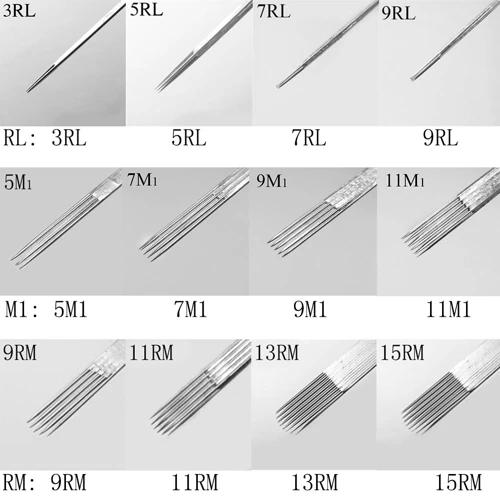
Coloring tattoos require a different type of needle than those used for lining. Generally, round and magnum needles can be used to color tattoos. Round needles are used to fill in small areas with solid color, while magnum needles are used to spread color in a more even fashion. When shading, use a round shader needle to build up the color in the shadows. To create a softer, blended look, use a magnum shader or a stacked magnum. For soft, hazy color, use a soft edge magnum. What tattoo needle do I use for shading depends on the desired effect and the size of the area. For larger areas, a multiple needle configuration such as a flat, curved or round magnum can be used. For smaller areas, a single needle configuration is preferable.
What Tattoo Needle Do I Use For Shading?
When it comes to selecting the right tattoo needle for shading, you will need to consider the size of the needle and the type of shading you are looking to achieve. A larger needle size is usually best for shading as it creates a wider, more even line. For example, a 5 or 8 round liner is recommended for a bold, solid line.
Round Shader Needles
Round shader needles are the most common type of needle used for shading. They come in a variety of sizes, from 3 to 15 round. The larger the number, the wider the needle and the more ink it will deposit. For example, a 15 round shader will deposit more ink than a 5 round.
Magnum Needles
Magnum needles are curved and come in sizes ranging from 3 to 14. They are used for creating a softer, more blended effect than a round shader. They can be used to create a gradient from dark to light, as well as for background shading.
M1 Needles
M1 needles are also curved, but they are slightly more narrow than magnum needles. They are best used for creating detailed, intricate shading. They are also great for creating a gradient, but they are not as good at creating a solid, bold line.
Conclusion
The size and type of tattoo needle you choose for shading will depend on the type of shading you are looking to achieve. For a bold, solid line, a 5 or 8 round shader is recommended. For softer, more blended shading, a magnum or M1 needle is best.
Frequently Asked Questions
What Type of Ink is Best to Use With a Tattoo Needle?
Pigment-based inks are the best type of ink to use with a tattoo needle. These inks are non-toxic, won’t fade over time, and are designed to last a lifetime. Pigment-based inks come in a wide range of colors, so you can create vibrant, detailed tattoos. However, they can be more expensive than other types of ink.
Organic inks are a more affordable option, but they can fade over time. They also tend to be more watery than pigment-based inks, and can be difficult to work with.
Vegan inks are a recent addition to the tattoo industry and are becoming increasingly popular. These inks are made from vegan-friendly ingredients and are free from animal products, chemicals, and other potentially hazardous substances. They are also non-toxic and long-lasting, making them a good choice for those looking for a more eco-friendly option.
Is there a difference between a thick and thin line when it comes to tattoo needles?
Yes, there is a difference between a thick and thin line when it comes to tattoo needles. The size of the needle determines how thick or thin the line will be. Needles with a larger diameter create thicker lines, while needles with a smaller diameter create thinner lines. The size of the needle also determines how much ink will be deposited and the speed at which the line is created.
What are the different types of needles used for tattooing?
Tattoo needles come in a variety of sizes and configurations, each suited for different types of tattoos. The most common types of needles used for tattooing are:
- Round Liner Needles – Round liner needles are used for lining and detail work. They are usually arranged in groups of three to seven needles, and can range in diameter from 0.25mm to 3mm.
- Round Shader Needles – Round shader needles are used for shading and coloring. They are usually arranged in groups of five to eleven needles, and can range in diameter from 0.25mm to 5mm.
- Flat Shader Needles – Flat shader needles are used for shading larger areas of a tattoo. They are usually arranged in groups of two to five needles, and can range in diameter from 0.25mm to 3mm.
- Magnum Needles – Magnum needles are used for shading and coloring larger areas of a tattoo. They are usually arranged in groups of three to five needles, and can range in diameter from 0.5mm to 6mm.
- Curved Magnum Needles – Curved magnum needles are used for shading and coloring curved areas of a tattoo. They are usually arranged in groups of three needles, and can range in diameter from 0.5mm to 6mm.
How Often Should a Tattoo Needle be Changed During a Session?
- For lining: Change the needle after every 15-20 minutes of use.
- For shading: Change the needle after every 20-30 minutes of use.
- For color packing: Change the needle after every 30-45 minutes of use.
- For filling: Change the needle after every 45-60 minutes of use.
It is important to change the needle regularly throughout the tattooing process to ensure the highest quality tattoo result and also to reduce the risk of infection.
Is it Possible to Make a Tattoo with a Thicker Line Using a Single Needle?
Yes, it is possible to create a thicker line when using a single needle. A single needle is capable of creating a variety of line widths, but the thicker the line, the more pressure that needs to be applied. Professional tattoo artists use a combination of techniques to create thicker lines, such as increasing the voltage of the needle or using a larger or dual needle setup. Additionally, the type of needle used can also have an impact on the line thickness. For example, a round liner needle will produce a thinner line than a magnum needle.
Conclusion
Tattoo needles come in a variety of sizes and shapes, with each size having its own purpose. The larger the needle, the thicker the lines it will produce. For the thickest lines, an 8-round or a 5-round magnum needle are the best options. Ultimately, the needle size and shape will depend on the details of the tattoo design being created.